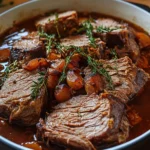For years, Sunday dinners at our house were a sacred ritual, and at the heart of many of those cherished meals was my grandmother’s beef pot roast. The aroma alone, filling the house with the promise of tender beef and savory vegetables, was enough to make anyone’s mouth water. This isn’t just a recipe; it’s a memory, a hug on a plate, and a testament to simple ingredients transformed into something extraordinary. Even my pickiest eaters, who usually turn their noses up at anything remotely vegetable-like, would devour every last bite of this pot roast, carrots and potatoes included! It’s become a staple in my own kitchen, a go-to for special occasions and cozy weeknights alike. If you’re looking for a recipe that’s guaranteed to impress and warm you from the inside out, look no further. This beef pot roast recipe is it – easy to make, incredibly flavorful, and utterly irresistible. Get ready to experience the magic of slow-cooked perfection!
Ingredients: Your Pot Roast Shopping List
- 3-4 lb Chuck Roast: The star of the show! Chuck roast is ideal for pot roast due to its marbling and connective tissue, which break down during slow cooking to create incredibly tender and flavorful beef.
- 1 tbsp Olive Oil: Used for searing the roast, adding depth of flavor and a beautiful crust. You can substitute with other cooking oils like vegetable or canola oil.
- 1 large Onion: Adds a foundational savory sweetness to the roast and braising liquid. Yellow or white onions work best.
- 3-4 Carrots: Contribute sweetness and vibrant color to the dish. Choose medium to large carrots, peeled and cut into chunks.
- 3-4 Potatoes: Starchy potatoes like Russets or Yukon Golds hold their shape well during long cooking and become wonderfully tender. Cut into large chunks.
- 2 Celery Stalks: Adds a subtle, aromatic flavor dimension to the braising liquid. Cut into large pieces.
- 4 cloves Garlic: Infuses the pot roast with pungent, aromatic flavor. Minced or roughly chopped.
- 1 (14.5 oz) can Diced Tomatoes, undrained: Adds acidity and depth of flavor to the braising liquid. Undrained tomatoes provide extra moisture and flavor.
- 1 cup Beef Broth: The liquid base for braising, adding rich beef flavor. Low sodium broth is recommended to control salt levels.
- 1/2 cup Red Wine (Optional): Enhances the depth and complexity of the sauce. A dry red wine like Cabernet Sauvignon or Merlot works well. Can be substituted with more beef broth.
- 2 tbsp Tomato Paste: Concentrated tomato flavor that adds richness and umami to the braising liquid.
- 1 tbsp Worcestershire Sauce: Adds a savory, umami depth and complexity to the sauce.
- 1 tsp Dried Thyme: A classic herb that complements beef beautifully, adding earthy and slightly minty notes.
- 1 tsp Dried Rosemary: Another classic herb that pairs wonderfully with beef, offering a piney and aromatic flavor.
- 1 Bay Leaf: Adds a subtle, tea-like aroma to the braising liquid. Remember to remove it before serving.
- Salt and Black Pepper: Essential seasonings to enhance all the flavors. Use kosher salt and freshly ground black pepper for best results.
- 2 tbsp All-Purpose Flour (Optional, for gravy): Used to thicken the braising liquid into a gravy at the end.
Instructions: Step-by-Step Guide to Pot Roast Perfection
- Prepare the Beef: Pat the chuck roast dry with paper towels. This is crucial for achieving a good sear. Season generously on all sides with salt and pepper. Don’t be shy with the seasoning – this is your base flavor.
- Sear the Roast: Heat olive oil in a large Dutch oven or heavy-bottomed pot over medium-high heat. Once the oil is shimmering hot, carefully place the chuck roast in the pot. Sear on all sides until deeply browned, about 3-4 minutes per side. Searing creates a flavorful crust and locks in juices. Remove the roast from the pot and set aside.
- Sauté Aromatics: Reduce the heat to medium. Add the chopped onion and celery to the pot. Cook, stirring occasionally, until softened and translucent, about 5-7 minutes. Add the minced garlic and cook for another minute until fragrant, being careful not to burn the garlic.
- Deglaze the Pot (Optional but Recommended): If using red wine, pour it into the pot to deglaze. Scrape the bottom of the pot with a wooden spoon to loosen any browned bits (fond) stuck to the bottom. These browned bits are packed with flavor and will enhance your sauce. Cook for 1-2 minutes, allowing the wine to reduce slightly. If not using wine, simply skip this step and proceed to the next.
- Build the Braising Liquid: Add the diced tomatoes (undrained), beef broth, tomato paste, Worcestershire sauce, dried thyme, dried rosemary, and bay leaf to the pot. Stir well to combine all ingredients and scrape up any remaining fond from the bottom of the pot.
- Return the Roast and Add Vegetables: Return the seared chuck roast to the pot, nestled into the braising liquid. Add the carrots and potatoes around the roast. Ensure that the roast is mostly submerged in the liquid; add a little more beef broth if necessary.
- Braise in the Oven (or Stovetop):
- Oven Method (Recommended): Cover the Dutch oven tightly with a lid and transfer it to a preheated oven at 325°F (160°C). Braise for 3-4 hours, or until the beef is fork-tender and easily shreds apart. Check the roast after 3 hours; if it’s not tender, continue braising for another hour or until done.
- Stovetop Method: Bring the liquid to a simmer on the stovetop, then reduce the heat to low, cover the pot tightly, and simmer gently for 3-4 hours, or until the beef is fork-tender. Check occasionally to ensure the liquid is simmering gently and not boiling rapidly.
- Check for Doneness: The pot roast is done when the beef is incredibly tender and easily falls apart when pierced with a fork. The vegetables should also be tender but not mushy.
- Rest the Roast: Once cooked, remove the pot from the oven (or stovetop). Carefully remove the roast from the pot and place it on a cutting board. Tent it loosely with foil and let it rest for 15-20 minutes. Resting allows the juices to redistribute throughout the meat, resulting in a more tender and flavorful roast.
- Make Gravy (Optional): While the roast is resting, you can make a gravy from the braising liquid. Skim off excess fat from the surface of the braising liquid. In a small bowl, whisk together all-purpose flour with a few tablespoons of the hot braising liquid to create a smooth slurry. Gradually whisk the slurry into the remaining braising liquid in the pot. Bring to a simmer over medium heat and cook, stirring constantly, until the gravy thickens to your desired consistency, about 5-10 minutes. Season with salt and pepper to taste.
- Shred and Serve: After resting, shred the beef roast using two forks. Return the shredded beef to the pot with the vegetables and gravy (if made). Stir gently to combine.
- Serve Hot: Serve the beef pot roast hot, ladling generous portions of beef, vegetables, and gravy over mashed potatoes, creamy polenta, egg noodles, or crusty bread. Garnish with fresh parsley or thyme, if desired.
Nutrition Facts: A Delicious and Wholesome Meal (per serving, approximate)
- Serving Size: 1 serving (approximately 1.5 cups)
- Calories: 450-550 kcal (estimated, varies based on portion size and ingredients)
- Protein: 40-50g
Note: Nutritional information is an estimate and can vary depending on specific ingredients used and portion sizes. For accurate nutritional information, use a nutrition calculator with specific ingredient brands and weights.
Preparation Time: Plan Your Cooking Schedule
- Prep Time: 30 minutes (chopping vegetables, searing beef, assembling ingredients)
- Cook Time: 3-4 hours (braising time, mostly hands-off)
- Total Time: 3.5 – 4.5 hours (from start to finish)
This recipe is perfect for a weekend meal or a day when you have time for slow cooking. The long braising time is essential for tenderizing the beef and developing rich flavors.
How to Serve: Elevating Your Pot Roast Experience
- Classic Pairings:
- Mashed Potatoes: Creamy mashed potatoes are the quintessential side for pot roast, perfect for soaking up the flavorful gravy.
- Egg Noodles: Tender egg noodles are another excellent option to serve with pot roast and gravy.
- Polenta: Creamy polenta provides a comforting and delicious base for the pot roast.
- Crusty Bread: Serve with crusty bread for dipping into the gravy and soaking up all the delicious juices.
- Vegetable Sides:
- Roasted Asparagus: A simple and elegant side that complements the richness of the pot roast.
- Green Beans Almondine: Buttery green beans with toasted almonds add a touch of freshness and crunch.
- Steamed Broccoli: A healthy and easy side that balances the richness of the pot roast.
- Side Salad: A fresh green salad with a vinaigrette dressing can provide a light counterpoint to the hearty pot roast.
- Garnishes:
- Fresh Parsley or Thyme: Sprinkle chopped fresh herbs over the pot roast for a pop of color and freshness.
- Sour Cream or Greek Yogurt: A dollop of sour cream or Greek yogurt can add a creamy tanginess.
- Chives or Scallions: Finely chopped chives or scallions add a mild oniony flavor and visual appeal.
Additional Tips for Pot Roast Mastery
- Choose the Right Cut of Beef: Chuck roast is the best choice for pot roast. It has ample marbling and connective tissue that breaks down during slow cooking, resulting in incredibly tender and flavorful meat. Avoid leaner cuts like round roast, which can become dry and tough.
- Don’t Skip the Sear: Searing the beef is a crucial step. It creates a flavorful crust and deepens the overall flavor of the pot roast. Make sure your pot and oil are hot before adding the roast.
- Build Flavorful Layers: Sautéing the onions, celery, and garlic before braising builds a flavorful base for the dish. Deglazing the pot with red wine (or broth) after searing also adds depth and complexity.
- Use Quality Broth: Using a good quality beef broth will significantly enhance the flavor of your pot roast. Low sodium broth is recommended so you can control the salt level.
- Don’t Overcrowd the Pot: Make sure the roast and vegetables are in a single layer in the pot. Overcrowding can lead to steaming instead of braising and uneven cooking. If necessary, use a larger pot or cook in batches.
- Braise Low and Slow: Low and slow braising is key to tenderizing the beef and developing rich flavors. Resist the temptation to rush the cooking process.
- Check for Tenderness, Not Time: Cooking time can vary depending on the size and thickness of your roast, as well as your oven. The best way to check for doneness is to pierce the beef with a fork. It should be fork-tender and easily shreddable.
- Rest the Roast Before Shredding: Resting the roast after cooking is crucial. It allows the juices to redistribute, resulting in a more tender and flavorful final product. Tent it loosely with foil for at least 15-20 minutes before shredding.
Frequently Asked Questions (FAQ) About Beef Pot Roast
Q1: Can I make pot roast in a slow cooker?
A: Yes, absolutely! Slow cookers are fantastic for pot roast. Sear the beef and sauté the aromatics as instructed, then transfer everything to your slow cooker. Cook on low for 6-8 hours or on high for 3-4 hours, or until the beef is fork-tender. Add the vegetables in the last 2-3 hours of cooking to prevent them from becoming mushy.
Q2: What if I don’t have red wine? Can I still make pot roast?
A: Yes, you can definitely make pot roast without red wine. Simply substitute the red wine with an equal amount of beef broth. While red wine adds depth of flavor, the pot roast will still be delicious without it.
Q3: Can I use different vegetables in my pot roast?
A: Absolutely! Feel free to customize your pot roast with your favorite root vegetables. Parsnips, turnips, sweet potatoes, and butternut squash are all great additions. You can also add mushrooms during the last hour of cooking.
Q4: My pot roast is tough. What did I do wrong?
A: Tough pot roast is usually a result of undercooking. Chuck roast needs to be braised for a long time to break down the connective tissue and become tender. Make sure you are braising it for at least 3-4 hours, or until it is easily fork-tender. Another reason could be using a leaner cut of beef. Stick to chuck roast for the best results.
Q5: How do I thicken the gravy if it’s too thin?
A: If your gravy is too thin after braising, you can thicken it using a cornstarch or flour slurry. Whisk together 1-2 tablespoons of cornstarch or flour with an equal amount of cold water to create a slurry. Gradually whisk the slurry into the simmering braising liquid and cook, stirring constantly, until the gravy thickens to your desired consistency.
Q6: Can I make pot roast ahead of time?
A: Yes, pot roast is a great make-ahead meal. In fact, it often tastes even better the next day! You can make the pot roast 1-2 days in advance. Let it cool slightly, then store it in an airtight container in the refrigerator. Reheat gently on the stovetop or in the oven before serving.
Q7: Can I freeze leftover pot roast?
A: Yes, leftover pot roast freezes well. Let it cool completely, then transfer it to freezer-safe containers or bags. Freeze for up to 2-3 months. Thaw overnight in the refrigerator before reheating.
Q8: What are some other ways to use leftover pot roast?
A: Leftover pot roast is incredibly versatile! You can use it to make:
* Pot Roast Sandwiches: Shredded pot roast on crusty rolls with gravy.
* Pot Roast Shepherd’s Pie: Top mashed potatoes with a layer of shredded pot roast and vegetables, then bake.
* Pot Roast Tacos or Burritos: Shredded pot roast in tortillas with your favorite taco or burrito toppings.
* Pot Roast Chili: Add leftover pot roast to your favorite chili recipe for extra flavor and heartiness.
Enjoy making this comforting and delicious beef pot roast recipe! It’s sure to become a family favorite in your home too.
Print
Beef Roast Pot Recipe
Ingredients
- 3–4 lb Chuck Roast: The star of the show! Chuck roast is ideal for pot roast due to its marbling and connective tissue, which break down during slow cooking to create incredibly tender and flavorful beef.
- 1 tbsp Olive Oil: Used for searing the roast, adding depth of flavor and a beautiful crust. You can substitute with other cooking oils like vegetable or canola oil.
- 1 large Onion: Adds a foundational savory sweetness to the roast and braising liquid. Yellow or white onions work best.
- 3–4 Carrots: Contribute sweetness and vibrant color to the dish. Choose medium to large carrots, peeled and cut into chunks.
- 3–4 Potatoes: Starchy potatoes like Russets or Yukon Golds hold their shape well during long cooking and become wonderfully tender. Cut into large chunks.
- 2 Celery Stalks: Adds a subtle, aromatic flavor dimension to the braising liquid. Cut into large pieces.
- 4 cloves Garlic: Infuses the pot roast with pungent, aromatic flavor. Minced or roughly chopped.
- 1 (14.5 oz) can Diced Tomatoes, undrained: Adds acidity and depth of flavor to the braising liquid. Undrained tomatoes provide extra moisture and flavor.
- 1 cup Beef Broth: The liquid base for braising, adding rich beef flavor. Low sodium broth is recommended to control salt levels.
- 1/2 cup Red Wine (Optional): Enhances the depth and complexity of the sauce. A dry red wine like Cabernet Sauvignon or Merlot works well. Can be substituted with more beef broth.
- 2 tbsp Tomato Paste: Concentrated tomato flavor that adds richness and umami to the braising liquid.
- 1 tbsp Worcestershire Sauce: Adds a savory, umami depth and complexity to the sauce.
- 1 tsp Dried Thyme: A classic herb that complements beef beautifully, adding earthy and slightly minty notes.
- 1 tsp Dried Rosemary: Another classic herb that pairs wonderfully with beef, offering a piney and aromatic flavor.
- 1 Bay Leaf: Adds a subtle, tea-like aroma to the braising liquid. Remember to remove it before serving.
- Salt and Black Pepper: Essential seasonings to enhance all the flavors. Use kosher salt and freshly ground black pepper for best results.
- 2 tbsp All-Purpose Flour (Optional, for gravy): Used to thicken the braising liquid into a gravy at the end.
Instructions
- Prepare the Beef: Pat the chuck roast dry with paper towels. This is crucial for achieving a good sear. Season generously on all sides with salt and pepper. Don’t be shy with the seasoning – this is your base flavor.
- Sear the Roast: Heat olive oil in a large Dutch oven or heavy-bottomed pot over medium-high heat. Once the oil is shimmering hot, carefully place the chuck roast in the pot. Sear on all sides until deeply browned, about 3-4 minutes per side. Searing creates a flavorful crust and locks in juices. Remove the roast from the pot and set aside.
- Sauté Aromatics: Reduce the heat to medium. Add the chopped onion and celery to the pot. Cook, stirring occasionally, until softened and translucent, about 5-7 minutes. Add the minced garlic and cook for another minute until fragrant, being careful not to burn the garlic.
- Deglaze the Pot (Optional but Recommended): If using red wine, pour it into the pot to deglaze. Scrape the bottom of the pot with a wooden spoon to loosen any browned bits (fond) stuck to the bottom. These browned bits are packed with flavor and will enhance your sauce. Cook for 1-2 minutes, allowing the wine to reduce slightly. If not using wine, simply skip this step and proceed to the next.
- Build the Braising Liquid: Add the diced tomatoes (undrained), beef broth, tomato paste, Worcestershire sauce, dried thyme, dried rosemary, and bay leaf to the pot. Stir well to combine all ingredients and scrape up any remaining fond from the bottom of the pot.
- Return the Roast and Add Vegetables: Return the seared chuck roast to the pot, nestled into the braising liquid. Add the carrots and potatoes around the roast. Ensure that the roast is mostly submerged in the liquid; add a little more beef broth if necessary.
- Braise in the Oven (or Stovetop):
- Oven Method (Recommended): Cover the Dutch oven tightly with a lid and transfer it to a preheated oven at 325°F (160°C). Braise for 3-4 hours, or until the beef is fork-tender and easily shreds apart. Check the roast after 3 hours; if it’s not tender, continue braising for another hour or until done.
- Stovetop Method: Bring the liquid to a simmer on the stovetop, then reduce the heat to low, cover the pot tightly, and simmer gently for 3-4 hours, or until the beef is fork-tender. Check occasionally to ensure the liquid is simmering gently and not boiling rapidly.
- Check for Doneness: The pot roast is done when the beef is incredibly tender and easily falls apart when pierced with a fork. The vegetables should also be tender but not mushy.
- Rest the Roast: Once cooked, remove the pot from the oven (or stovetop). Carefully remove the roast from the pot and place it on a cutting board. Tent it loosely with foil and let it rest for 15-20 minutes. Resting allows the juices to redistribute throughout the meat, resulting in a more tender and flavorful roast.
- Make Gravy (Optional): While the roast is resting, you can make a gravy from the braising liquid. Skim off excess fat from the surface of the braising liquid. In a small bowl, whisk together all-purpose flour with a few tablespoons of the hot braising liquid to create a smooth slurry. Gradually whisk the slurry into the remaining braising liquid in the pot. Bring to a simmer over medium heat and cook, stirring constantly, until the gravy thickens to your desired consistency, about 5-10 minutes. Season with salt and pepper to taste.
- Shred and Serve: After resting, shred the beef roast using two forks. Return the shredded beef to the pot with the vegetables and gravy (if made). Stir gently to combine.
- Serve Hot: Serve the beef pot roast hot, ladling generous portions of beef, vegetables, and gravy over mashed potatoes, creamy polenta, egg noodles, or crusty bread. Garnish with fresh parsley or thyme, if desired.
Nutrition
- Serving Size: one normal portion
- Calories: 550
- Protein: 50g






